
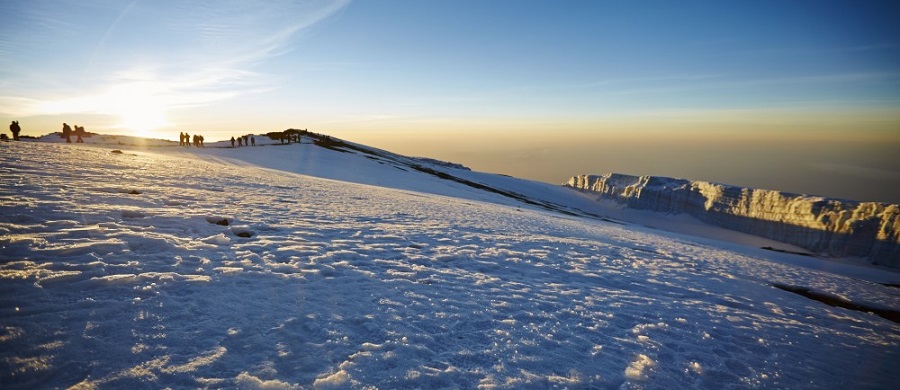
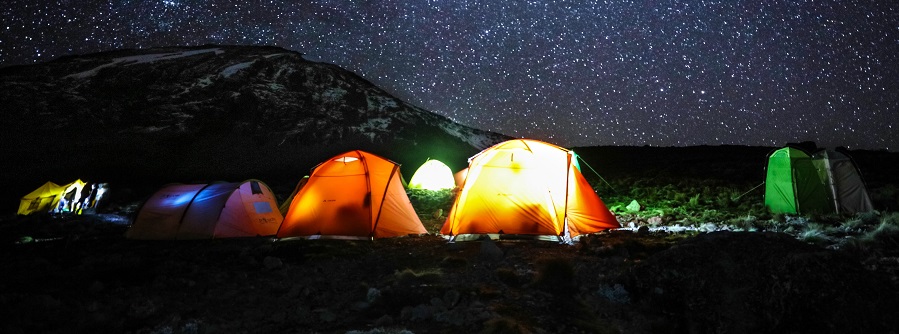
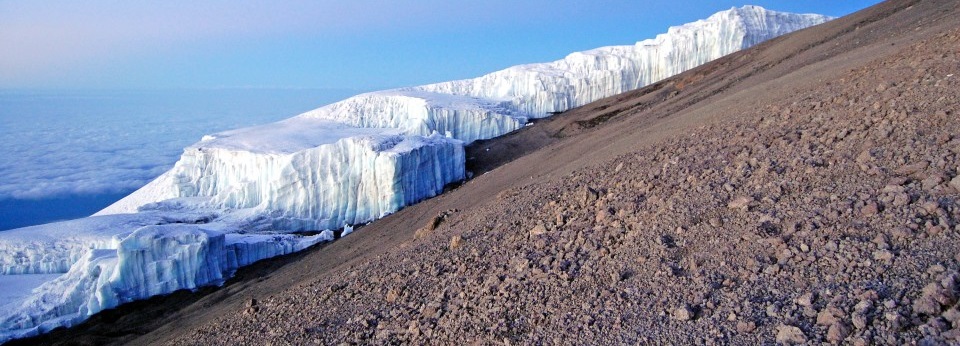
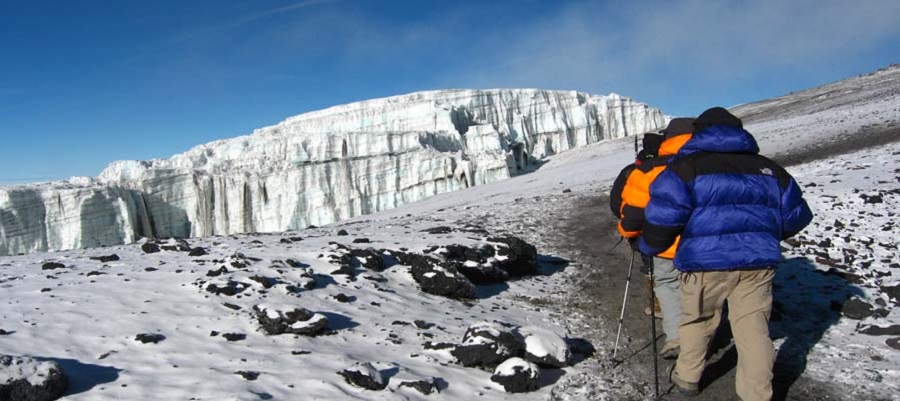
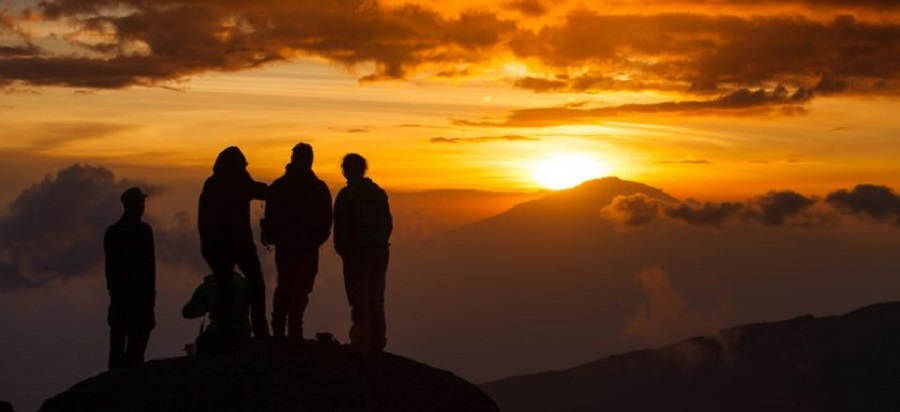
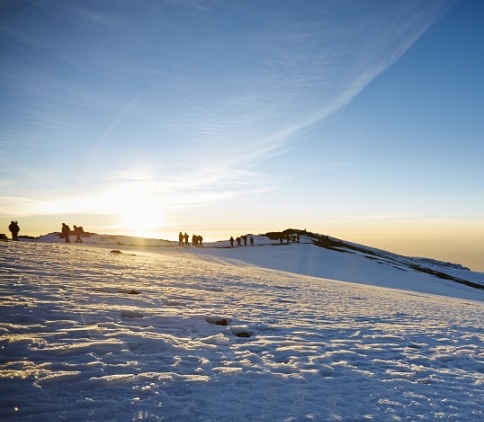
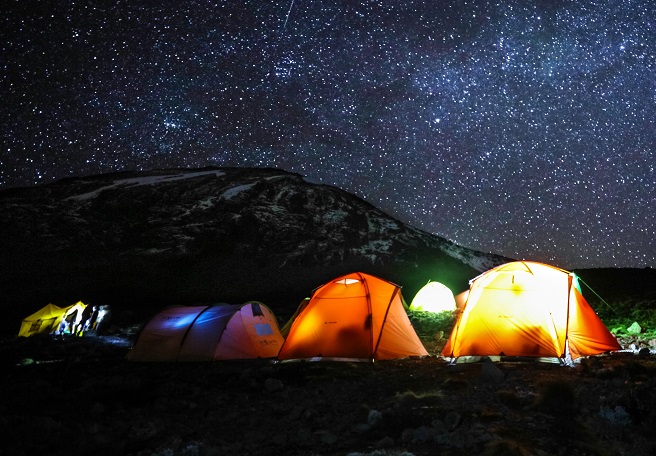
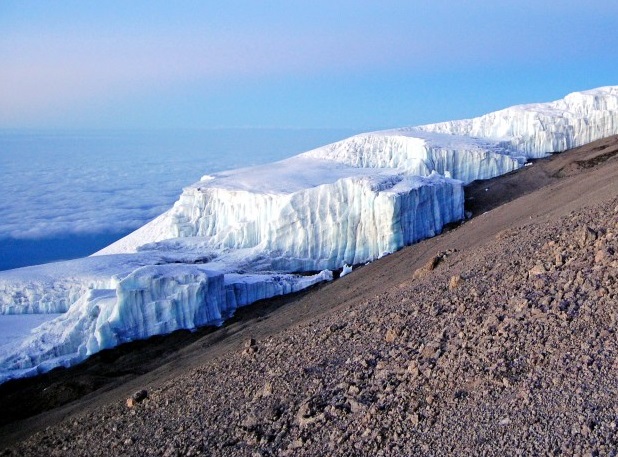
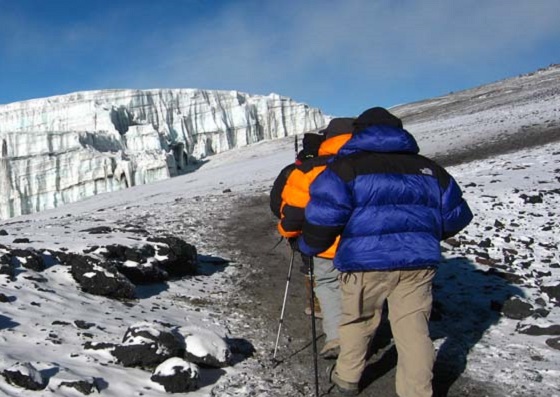
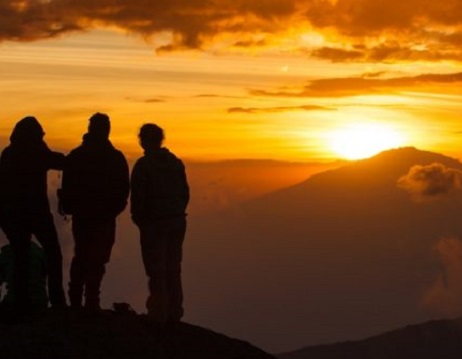
Bekend als de "Coca-Cola" -route, is de Marangu-route een klassieke trektocht op de Kilimanjaro. Het is de oudste, meest bekende route. Velen geven de voorkeur aan de Marangu-route, omdat deze als het gemakkelijkste pad op de berg wordt beschouwd, gezien de geleidelijke helling. Het is ook de enige route die slaaphutten biedt in accommodaties in slaapzalen. De minimaal vereiste dagen voor deze route zijn vijf. Marangu wordt vooral begunstigd tijdens het regenseizoen, waar de hutaccommodaties de voorkeur hebben boven natte grond. De Marangu-route, bekend als de "Coca-Cola" -route, nadert de Kilimanjaro vanuit het zuidoosten. Het is de oudste, meest bekende route. Velen geven de voorkeur aan de Marangu-route omdat deze als het gemakkelijkste pad op de berg wordt beschouwd, gezien de geleidelijke helling en het directe pad.
Maak een korte rit van de stad Moshi naar de Kilimanjaro Park Gate (1.830 m.). Ligt aan de rand van Marangu, een aantrekkelijk dorp met veel kleine koffie- en bananenplantages. Nadat we de toegangsformaliteiten hadden vervuld, klommen we omhoog door aantrekkelijk en ongerept bos om de open plek te bereiken met de Mandara Hut (2700 m.). De vulkanische overblijfselen van Maundi Crater zijn vlakbij, en een goede middagexcursie te maken. Een alternatief is om uit te rusten en te genieten van het prachtige bos. Bij de hutten is een rijk vogelleven en ook worden er vaak apen gezien. [3-5 uur lopen naar Mandara Hut]
Het eerste deel van de wandeling is een steile klim door het bos, maar het pad komt al snel uit in met gras begroeide heidevelden en bij helder weer zijn er goede uitzichten op de toppen van Kibo en Mawenzi. We klimmen gestaag door de heidegebied, met gigantische heide en af en toe een tribune van groundsel, om uiteindelijk Horombo Hut (3.720 m) te bereiken. Zonsopkomsten en zonsondergangen zijn hier vaak erg mooi, de locatie ligt dicht bij de begeerde koepel van Kibo en er heerst een echt gevoel boven de wolken te zijn. [4-6 uur lopen van Mandara Hut naar Horombo Hut] Overdekte afstand: 12,5 km / 7,8 m Ong. benodigde tijd: 9 uur Maaltijden: ontbijt, lunch en diner inbegrepen
We klimmen heel geleidelijk naar de maanwoestijn van het zadel tussen Mawenzi en Kibo. Het terrein verandert in dekvloer en er is een tastbaar gevoel van wildernis op grote hoogte. Meestal bereiken we tegen de middag de Kibo Hut (4.700 m.) Aan de onderkant van de kraterwand en de middag is vrij (om de beklimming van de top te overwegen !!). De rest van de dag wordt doorgebracht met rusten en eten ter voorbereiding op de slotklim voor een zeer vroege nacht! [4-5 uur lopen van Horombo Hut naar Kibo Hut] Overdekte afstand: 9,5km / 5,9m Ong. benodigde tijd: 7 uur Maaltijden: ontbijt, lunch en diner inbegrepen
Dag 4: Summit Day en vervolgens naar Horombo Hut We beginnen onze beklimming met fakkels om ongeveer 1 uur 's ochtends, zodat we bij zonsopgang op Gillman's Point kunnen zijn. De eerste klim is steil over het losse vulkanische scherm, maar er zijn een aantal goed gesorteerde zigzaggen en een langzaam maar gestaag tempo zal ons binnen ongeveer vijf of zes uur naar Gillman's (5.685 m.) Brengen. We zullen daar uitrusten en enige tijd doorbrengen met het inhalen van de zonsopgang. Degenen die zich nog steeds sterk voelen, kunnen de drie uur durende rondrit vanaf hier langs de kraterrand naar Uhuru Peak (5.896 m.) Maken, waarbij ze in de buurt komen van de spectaculaire gletsjers die nog steeds het grootste deel van het topgebied bezetten. De afdaling is verrassend snel en we keren terug naar Horombo Hut voor de nacht. [11-15 uur wandelen van Kibo Hut naar Gillman's Point] Afgelegde afstand: 22 km / 13.7 mijl Ong. tijd: 12 - 15 uur Maaltijden: ontbijt en lunch inbegrepen
Dag 5: Horombo Hut - Moshi Na het ontbijt beginnen we met een aangename moorlandse wandeling naar Mandara en vervolgens een mooie boswandeling naar de poorten van het Nationaal Park naar de stad Moshi. Overdekte afstand: 20,8 km / 12,9 m Ong. benodigde tijd: 8 uur Maaltijden: ontbijt en lunch inbegrepen
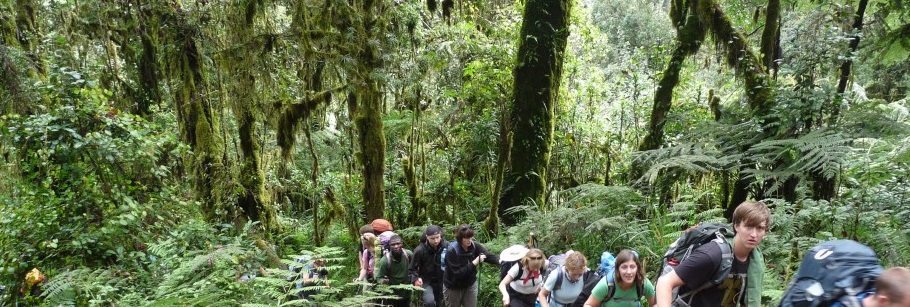
During the climb you will be staying at campsites!
mount kilimanjaro nature, mount kilimanjaro best route, mount kilimanjaro temperature, mount kilimanjaro water, mount kilimanjaro trekking companies, mount kilimanjaro reviews, mount kilimanjaro to safari, mount kilimanjaro from Canada, mount kilimanjaro trekking company, mount kilimanjaro trekking operator, mount kilimanjaro trekking operators, mount kilimanjaro trekking agency, mount kilimanjaro trekking from moshi, mount kilimanjaro from arusha, mount kilimanjaro machame route, mount kilimanjaro marangu route, mount kilimanjaro rongai route, mount kilimanjaro umbwe route, mount kilimanjaro lemosho route, mount kilimanjaro shira route, mount kilimanjaro westean circuit, mount kilimanjaro outfits, mount kilimanjaro trekking agences, mount kilimanjaro trekking adventures, mount kilimanjaro trekking adventure, mount kilimanjaro trekking holiday, mount kilimanjaro trekking duration, mount kilimanjaro books, mount kilimanjaro news, mount kilimanjaro trekking holidays, mount kilimanjaro trekking expeditions, mount kilimanjaro from japan , mount kilimanjaro trekking expedition, mount kilimanjaro trekking organizer, mount kilimanjaro from china, mount kilimanjaro trekking from dar es salam, mount kilimanjaro from londan, mount kilimanjaro from USA
The Machame route is the busiest of the seven Kilimanjaro routes, with about 50% of Kilimanjaro climbers using it each year. It’s also one of the most scenic Kilimanjaro routes. It offers breathtaking views and a rich variety of terrain throughout. The route approaches from south and has a high success rate, especially for climbers who choose the seven-day option
We really like the Machame route because of its beauty, variety of scenery, and great acclimatisation profile. The main downside of this route for us is that it can get quite crowded. Whilst it’s undeniably a very beautiful Kilimanjaro climb, we usually recommend the Lemosho route over the Machame route. This is because the Lemosho is just as beautiful, yet less crowded.
These two Kilimanjaro routes do, however, join together on the morning of Day 3, so it’s actually only the first couple of days that are different. You can climb Kilimanjaro via the Machame route in six days, though we don’t recommend this for first-time trekkers as itdiminishes your acclimatisation period. Rather climb it over seven days.
Highlights
Good acclimatization, High success rates, Beautiful scenery, Varying landscapes , Variety of terrain
The Machame route is one of the most beautiful of the seven Kilimanjaro routes in Tanzania. You pass through extremely varied terrain the whole way up to the summit. In fact, you pass through five different climate zones: rainforest, grassland, moorland, alpine desert, and the arctic summit. The trek also takes you past stunning natural features such as the volcanic plug known as Lava Tower. The Machame also route stops over at locations that offer some of the best sunrises and sunsets on Kilimanjaro.
How hard is the Machame route?
No Kilimanjaro climb is easy, so let’s get that out of the way straight off the bat! But you’re doubtless wanting to know how hard the Machame route is comparative to the other six routes. Well, it isn’t easy to state how hard a route is, especially as the things that might make a Kilimanjaro climb ‘hard’ can vary from person to person. Generally speaking, the Machame route is considered a more challenging climb than others. For starters, it covers more ground, having more ups and downs than other routes. This means it requires more energy per day than other trails. That said, the route is not technically difficult.
It’s also important to note that while it’s more physically demanding than other Kilimanjaro routes, the seven-day Machame route has a very good acclimatisation profile. This is because it includes opportunities to climb high and then sleep low, which are important in helping the body to adjust to the increased elevation. Proper acclimatisation increases your chances of summiting.
Put simply, with the right Kilimanjaro preparation, anyone should be able to climb Kilimanjaro via the Machame route. Note that you should be physically fit to temp the climb. But with the right support in the form of a qualified and supportive mountain crew, you can achieve the summit whether you have previous hiking experience or are a first-time trekker. Note too that we would not recommend the six-day Machame route for first-time trekkers. We really feel that the seven-day climb is the better option given its superior acclimatisation profile.
The Machame route provides ideal opportunities to climb high and then sleep low, which means it has an excellent acclimatisation profile. Whilst there are no official statistics, the average success rate across all Kilimanjaro operators is 85% for the seven-day Machame route. It drops to 73% for the six-day option. Follow Alice retains a success rate of 95% for the seven-day Machame route!
The Machame route can be completed in a minimum of six days, but we always recommend the seven-day Machame route itinerary. The extra day gives you more time to acclimatise. Further, climbing Kilimanjaro isn’t a race. The Machame route is very beautiful, so it would be a shame to rush it. In our experience, most people who have completed the right Kilimanjaro preparation complete the seven-day Machame route with no real problems.
The Machame route is the most frequented of the Kilimanjaro routes. It’s a very beautiful and scenic route, and also boasts an amazing acclimatisation profile, which attracts a lot of climbers each year. Also, the fact that you can climb it in six days means that a lot of budget Kilimanjaro operators use the Machame route.
The Machame route only offers camping accommodation. All of your camping equipment is provided for you as part of your package fee if you climb Kilimanjaro. This equipment includes your tent, sleeping bag, sleeping mat and pillow. Also, all tents are pitched and then taken down by our dedicated mountain crew throughout the trek.
Follow Alice offers the Machame route as a six- or seven-day group or private climb. The package costs $2,285 per person for a six-day climb and $2,585 per person for a seven-day climb (both based on double occupancy). This fee includes six or seven days on the mountain as well as one day either side at our beautiful partner lodge in Moshi. This brings the entire trip to nine or 10 days in total.
The Machame route can be completed in six or seven days. The extra day on the seven-day route allows for an extra day of acclimatisation, which is always a good thing. Have a look at the two itineraries below before deciding which option suits you.
You start the trek at Machame Gate. You head to the summit, then descend to exit the park at Mweka Gate. This means you don’t have to retrace your steps on the Machame route.
help?
Here’s a summary of the different routes up Kilimanjaro:
If you want to add a little adventure onto the end of your Kilimanjaro climb, we recommend going on a Tanzania safari – you won’t find a better African safari! Or hop over the border into Uganda to trek with mountain gorillas. Alternatively, if you’ve limited time and budget, why not do one or two extra activities in the Kilimanjaro region like visit a Maasai village or a coffee farm?
Machame route
The second most popular option among the climbers is the Machame route, also known as “the Whiskey Route”. This route offers a wide variety of views, landscapes and experiences. The starting point of the route, Machame Gate, is only a 20-minute drive from Aishi Machame Hotel. Located on the southern slope of Mt Kilimanjaro, Machame Gate will lead you to the top of Kilimanjaro along the exciting footpath which starts at thetropical forest, then runs through all the climate zones and finishes with the Arctic desert in the summit area. Camps along the trek are favorably located for a smooth and gradual acclimatization transition process. On the 3rd day Machame Route converges with Lemosho and Umbwe at Barranco camp.
The Machame Route
According to local accounts, the Italian Balletto discovered the Machame Route with the help of his dog. When trying to surpass complicated obstacles through the rain forest Balletto is said to have thrown a piece of meat for his dog who found the most efficient route to it. Balletto then forged his route by watching where his dog walked.
Probably just a myth, but a nice story anyway. We do know that the Park named a large glacier just to the east of the Diamond Glacier after Balletto as a gesture of thanks for making this very successful route. And it is a very successful route.
The Machame Route begins in the south west of the mountain and proceeds steeply north over two days until attaining the edge of the Shira Plateau at 3900m. From here it drops 50 metres to Shira Camp where it joins the Lemosho and Shira Routes onwards to the summit. From Shira Camp the view west over the jagged peaks forming the southern edge of the Shira Plateau is phenomenal at sunset. We usually take acclimatisation excursions from here a couple of hundred metres upwards to ensure a better night’s sleep and improved acclimatisation.
Access to the Machame Route is relatively straightforward and this is reflected in its costing slightly less to climb than all the other routes. There are imminent plans to tar the road all the way to the gate. We expect this to happen within the next year, if the government is able to meet its funding targets.
The Machame Route tends to be our most popular choice because the topography of the route is very conducive to good acclimatisation and the likelihood of summitting on this route is relatively high.
Machame is said to have two significant drawbacks. Firstly, there is the issue of the two obstacles on the route. Guidebooks make a point of telling readers how difficult the scrambling is on two particular features: just before reaching the Shira Plateau, and just after beginning the ascent of the steep Breach Wall after Barranco. These are not as frightening or difficult as is often claimed however. These two features are pictured at right and above at right. The picture at right looks precarious but there is just one stride that must be taken around this outcropping rock and if the climber is nervous of this move we send a member of staff to stand on the ledge underneath this rock and guide the climber’s feet if necessary. Thousands of people pass this way every year and we have never heard of any accidents here.
The second issue is the high numbers. It is true that in the peak of the northern hemisphere summer the Machame Route has many climbers on it. Team Kilimanjaro however has a means of minimizing the impact of this by leaving camp each morning much earlier than other groups, thereby also ensuring better weather. During bad weather the clouds typically roll in around lunch time. Though that said, it is actually possible to enjoy rain all day long!
The principal advantage of the Machame Route over the standard Rongai, Umbwe and Marangu Routes is that day 3 ascends from 3847m to only 3984m, yet via 4642m at the base of a volcanic rocky outcrop known as the Lava Tower. The 600m height differential ensures that Machame exploits the ‘climb high, sleep low’ principle to maximum effect. This and the fact that the summit assault on the Machame Route is via a ridge rather than a loose scree slope and is therefore considerably less difficult than the assault on Marangu and the standard Rongai Route, is responsible for the fact that Machame boasts the best summit success rates of all the routes after the TK Rongai Route.
Most climbers opt for the 7-day route in order to err on the side of caution with respect to being well rested and adequately acclimatised prior to their assault, however timings on the 6 day route are still safe and most people with active lifestyles and who are younger than around 45 years of age, and not carrying significant excess body mass, will usually manage very well on the 6 day Machame Route.
The climb begins at Machame Gate, at an altitude of 1800 metres, with an approach to the south west of the mountain. It passes through majestic rainforest on the first day, before continuing up the mountain to reach Shira Camp, where the Lemosho route joins from the west. From here you traverse the southern side of the mountain to Barranco via Lava Tower, and climb the Great Barranco Wall on your way to Barafu Camp. After reaching the summit, you will descend by the Mweka trail, rather than retracing your steps along the ascent route.
The Machame route is nicknamed the ‘Whiskey Route’ as it is considered more difficult than the ‘Coca Cola Route’, the nickname for the Marangu route. In reality, it is not more technically difficult, but is longer and in places steeper. The longer distance and the opportunity to ‘walk high, sleep low’ offer much better acclimatisation and as a result a very high success rate.
The Machame route is a good seven-day hike for those who have not trekked much at high altitudes, with an effective extra day’s acclimatisation, giving a better success rate. Experienced and already acclimatised mountaineers may opt for the more difficult 6-day ascent along the Machame route.
The Machame route is considered relatively tough. Depending on your level of fitness, you will be trekking for 6-7 hours nearly every day, at increasingly higher altitude. For the summit ascent, you will need to be prepared for a whopping 12-15 hours on your feet! Climbing up for 6-8 hours and descending back down for 6-7 hours. Arriving in great physical condition and with a tough mental "Kandoo" attitude will be your key to success!
Novice climbers are sometimes nervous about how they will cope with the Great Barranco Wall, but this is just a short scramble that is really not that tricky - you will be helped by your guide every step of the way. One stride around a rock outcrop is the most precarious part you will experience. Thousands of climbers safely travel this route each year, let alone the Kilimanjaro porters carrying heavy loads.
Mount Kilimanjaro: Machame Route is a 57.0 kilometer heavily trafficked point-to-point trail located near Kibosho Magharibi, Kilimanjaro, Tanzania that features beautiful wild flowers and is rated as difficult. The trail is primarily used for hiking, walking, camping, and backpacking.
The Machame route, commonly referred to by many as the Whiskey route, is the most popular route on Kilimanjaro. The major drawcard is its scenic beauty – but that doesn’t mean it's an easy trek to embark on.
The trail itself is considered to be difficult and steep, which is mostly attributed to its shorter itinerary length. If you classify yourself as a more ‘experienced’ hiker; meaning you have some experience with higher altitudes and enjoy long, steep walks, then this might be the right trail for you.
Previous trekking experience is highly recommended, as the days will feature 6-8 hours hiking with daily ascents of 900m to 1,000m, perhaps with the odd day ascending around 1,100m to 1,200m. Depending on the route, you may be trekking at an altitude of over3,500m.
You need complete confidence in your ability to trek for many days over difficult terrain. Extremes of altitude and weather may be encountered, as may the use of ice axes and crampons. A degree of physical and mental stamina will be essential to complete the hike as the days will be tiring.
The Machame route has a fairly good success rate, thanks to many ups and downs allowing better acclimatisation. To ensure a higher success rate it is best to take your time. The 7-day itinerary has an average summit success rate of 85%. For the 6-day itinerary success rate drops to 75% on average.
Route tips
Oldest person to ever summit
87 year-old Frenchman Valtee Daniel
Youngest person to ever summit
7 year-old Keats Boyd
Name and height of summit
Uhuru Peak is 5,895 m or 19,341 feet high
Amount of climbers annually
Approximately 25,000 people attempt to summit Mt. Kilimanjaro annually
Read also
1. Duration: The journey to the Uhuru peak via the Machame route can take anywhere between 6-7 days to complete. Travellers looking to shorten the journey can skip the night spent in the Karanga Valley. Barafu Camp is also part of the itinerary
2. Location: The Machame route starts in the southern region of Mount Kilimanjaro, and can be accessed via a 45-minute drive from Moshi to the Machame Gate, where the trek starts.
Travelling from the south of Mount Kilimanjaro, the journey will see you wandering past impressive, verdant forests on the way to the Shira Plateau. Then, hikers will find themselves surrounded by the Southern Ice Field before eventually reaching the summit.
The journey will involve many ups and downs along the trail, but on the plus side, this allows for much greater acclimatisation which can mean a higher success rate in reaching the summit. Finally, the descent is made via the Mweka route.
Any physical activity you can do beforehand will help make your ascent more enjoyable. As for how hard you train, this will depend on whether you're aiming for the Uhuru Peakor embarking on a shorter journey and will be different for everyone.
You can climb the Machame route year-round, but it may be wet and cold which means you should be equipped with the right waterproof gear. Consider climbing between January–March and June–October. Note that April, May and November are the wettest months.
While trekking tour operators may supply some of the gear you’ll need, there are a few non-negotiables you will need that includes waterproof clothing, a headlamp, sunglasses, appropriate hiking boots, personal medication, a non-disposable water bottle and a cap or a beanie for example.
Before you start your hiking escapade to the summit of Mount Kilimanjaro, you will need to establish how to get there, and the best mode of transport to suit your itinerary or tour. Travellers flying from the UK, the US, Australia or Canada and other parts of the world have a few options to explore.
Mount Kilimanjaro welcomes hikers of all levels of fitness and ability, but if you’re planning to reach the summit, careful planning and vigorous training is vital. Consider adding extra time to your itinerary to avoid altitude sickness and to enjoy your time climbing Kilimanjaro.
Each visitor will be required to pay a fee per person, per day for the conservation fee to help manage the national park, however, most tours will cover the permits and entry fees are included in the price.
The Machame Route has become the most common, albeit, the highest traffic route, due to its greater success rate than Marangu, overtaking it in recent times but also a preferred choice with fitter climbers who have a good chance of reaching the summit given an extra day of acclimatization. It is an affordable trail, delightfully and unforgettable wilderness expanses disturbed only by a narrow track dotted by trekkers, winding into the misty hills. Overnight camps are in sturdy four season tents carried by Uhuru Trails porters.
The Machame Route now vies with – and indeed over the last few years has overtaken – the Marangu Route as the most popular trail. Machame is also the regarded by many guides as the most enjoyable, though it is longer and, according to most, more arduous. Despite this, the success rate on the Machame Route is higher than on the Marangu Route, possibly because the Machame is a day longer at six days and five nights (assuming you take the Barafu Route to the summit) which gives trekkers more time to acclimatize. An extra acclimatization day can – and usually is – taken in the Karanga Valley. The Machame Route also gives you the option of taking the Western Breach / Arrow Glacier Route to the summit.
Where does the Machame Route go?
It is not difficult to see why the Machame Route is so popular with everyone: beginning on the south-western side of the mountain, this 40.16km trail (36.7km if trekking via the Western Breach) passes through some of the mountain’s finest features, including the cloud forest of Kili’s southern slopes, the dry and dusty Shira Plateau and the delightful senecio-clad Barranco Campsite. To reach the actual summit you have a choice of two paths: most people head for the lengthy, long-winded climb up the Barafu trail, with the Rebmann Glacier edging into your field of vision on your left as dawn breaks behind Mawenzi behind you. Alternatively, the more adventurous can go on the Western Breach Route, departing from the regular trail at Lava Tower on the western side of Kibo before heading up to chilly Arrow Glacier Campsite, then pressing on from there to the crater floor, gaining access to the crater at a point near the Furtwangler Glacier. Many people will spend a night here at the Crater Campsite, before pushing on up the crater’s southern rim to Uhuru Peak.
Unlike the Marangu Route, on the Machame Route you don’t use the same path to descend as you took to climb up the mountain, but instead you come down via the Mweka Route, a steep but very pretty descent encompassing inhospitably dry mountain desert and lush lowland forest in a matter of a few hours.
Curiously, though the Machame Route is widely reckoned to be harder than the Marangu Route (and is thus nicknamed the Whiskey Route, in opposition to Marangu’s softer soubriquet of the ‘Coca Cola trail’), the proportion of trekkers who reach the top using this route is marginally but significantly higher. Whether this is evidence that the Machame Route allows people to acclimatize better because it’s longer, particularly if you opt to take the Barafu Route to the summit, or whether this higher success rate is merely an indication that more experienced, hardened trekkers – ie the very people who are most likely to reach the summit – are more inclined to choose this route, is anyone’s guess.
How long does the Machame Route take?
The Machame Route via Barafu traditionally lasts for six days and five nights, though it is becoming more common for trekkers to opt for an extra night during the ascent, usually above the Karanga Valley. Not only does the extra day aid acclimatization but this also reduces from almost six to three the number of hours walked on the day that precedes the exhausting midnight ascent to the summit, thereby allowing trekkers more time to recover their faculties, relax and prepare themselves for the final push to the top. The book has a thorough day-by-day description of the Machame Route.
est Routes UKilimar
Best Routes Up Kilimanjaro
Deciding which trekking route to take to the summit of Kilimanjaro is best for you is very much a personal decision. But in this section we try to give you as much information as possible to help you make the best decision.
Ascending Kilimanjaro
As we mention in the introduction, the park authorities have designated six official paths leading up the slopes of Kili to Uhuru Peak
In addition to these trails there are a few ‘unofficial’ routes up Kilimanjaro, such as the Alternative Lemosho (aka Northern Circuit Route) and the Full Circuit Umbwe. These have ben constructed by the more creative agencies by combining segments of the above trails make a new route. These can be some of the best hiking trails around, with high success rates and fewer crowds.
Eventually, each of these six official Kilimanjaro routes reach the foot of the main Kibo summit. This is the snowy peak that you see in all the photos. From the foot of Kibo, three paths then take you up to Kibo’s crater rim. They are: